This topic describes how to navigate grids of data in LabKey Sample Manager, and how to filter, search, and sort your data.
- Grid Menus
- Work with Data Grids
- Data Entry and Edit Grids
- Export
Column Header Menus
Click the column header in a grid to access the column header menu:
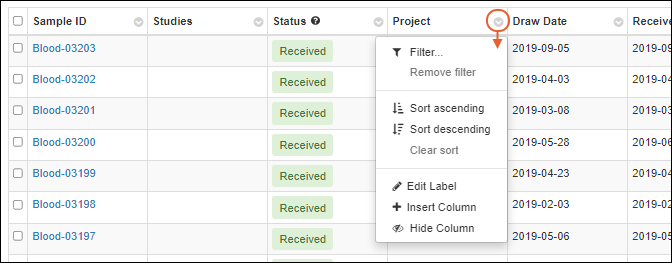
- Filter: Click to add or edit filters; by default the current column is selected in the popup.
- Remove filter: Remove the filter on this column.
- Sort ascending
- Sort descending
- Clear sort: Remove the sort on this column.
- Edit Label: Edit the display label for this column.
- Insert Column: Select a new column to add to the grid.
- Hide Column: Hide this column from the grid.
You can also drag and drop column headers to new positions in the grid. Learn about creating custom grids in this topic:
Scroll Large Grids
When scrolling a grid horizontally, the leftmost column, typically the SampleID, will remain 'locked' or visible on the left, making it easy to understand which sample the visible fields are referring to.

When the data grid is long enough to scroll vertically, such as when using a long 'page size' the column headers will remain visible at the top.
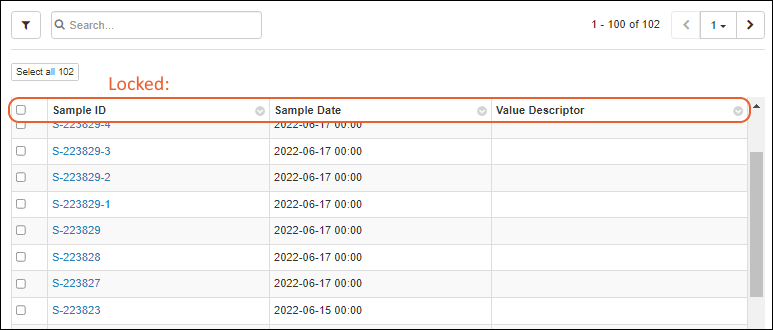
Sample Grid Menus
Sample grid menus highlight the most common sample actions and group them by category:

- Add:
- Edit:
- Derive:
- Assay:
- Picklists:
- Jobs:
- Storage:
- Find Derivatives: Open the Sample Finder using any filters applied to the current grid as search criteria for finding derived/child samples.
When the browser window is narrower, the secondary menus will be collapsed into a
More menu with sections for each category, and the filter and search widgets may move to a second line:

Select Rows
In LabKey Sample Manager, data is shown in grids, with a column of checkboxes on the left for selecting each individual row. Check the box in the header row to select all rows on the
current page.
Once you've selected a page of rows, you will see buttons to select all the rows, or clear those already checked.
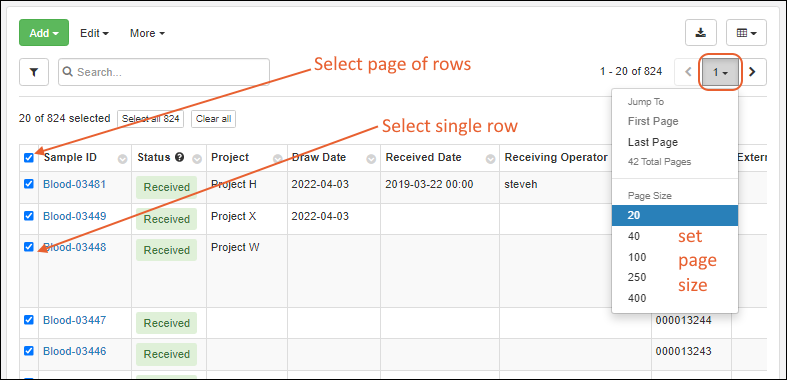
Page Through Data
Large sets of data are displayed on a paged grid. In the upper right, you see which rows you are viewing (here 1-20 of 824). Buttons give you the following control:
- and : Step one page forward or back.
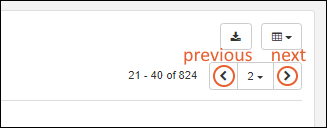
- The page number you are on is shown with a dropdown menu.
- You can jump to the first page or last page and see a count for the total number of pages.
- You can also change the pagination. Options for number of rows per page: 20, 40, 100, 250, 400.
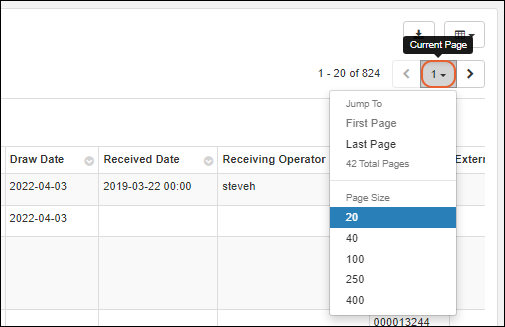
Filter
Use the
Filter option on any column header menu, or click the
button above the grid to open the filter panel.
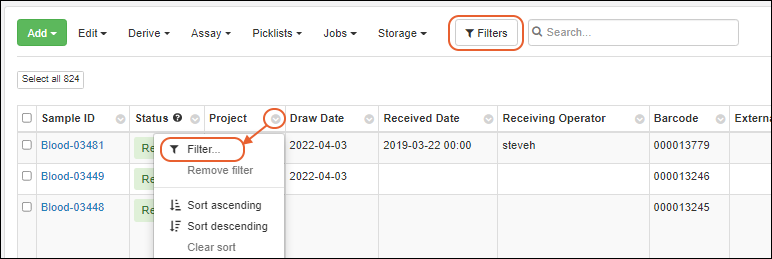
Select the column you want to filter on the left, then for any column, you can select one or two filtering expressions on the
Filter tab. If your first filtering expression cannot be further filtered (such as "Is Blank") you will not see the second filter option.
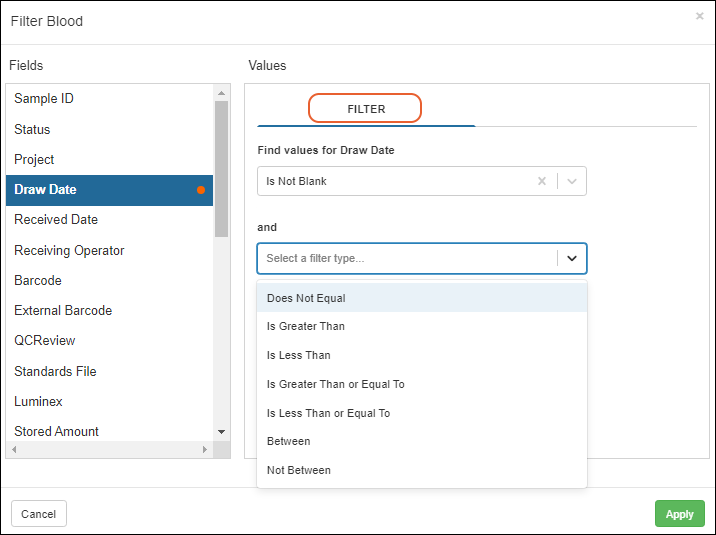
For columns with a limited set of values, you can use checkboxes on the
Choose Values tab to select the desired values.
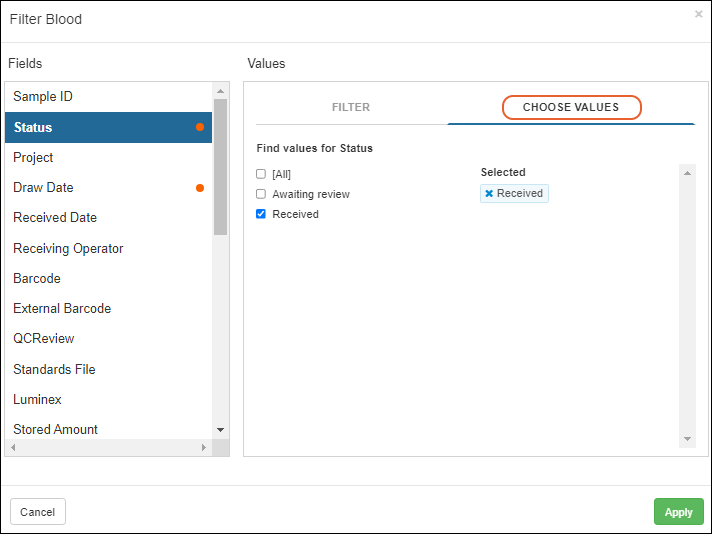
You'll see a filter icon in the header when a column filter is applied, as well as a "lozenge" for each filter above the grid. When you hover over a lozenge, the filter icon will become an X you can click to delete that filter. Click
Remove all to remove all the filters.
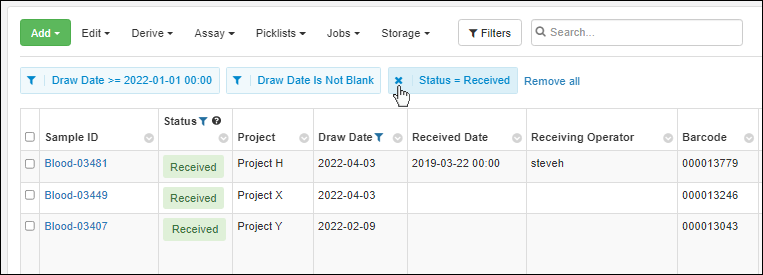
Sort by Column Value
In each header, click the
to sort the grid by the values in that column. Select either ascending or descending sort.

Once you have sorted a column, an indicator icon (
or
) will be added to the column header.
Search Grid
Enter your search terms in the
Search box above the grid to search the text fields in the grid. Click the X to clear the search terms.
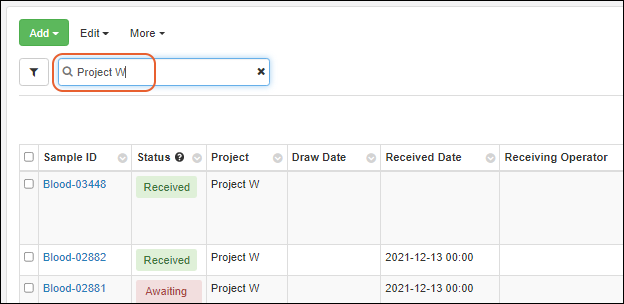
Editable Grids
Editable grids can be found throughout the application for entering and editing data for Samples, Sources, Assays, etc. When using an editable grid, you can make use of the following options:
- The contents of the grid can be exported by clicking the button. Choose CSV, TSV, or Excel format exports. Fields from all tabs of the editable grid will be included in the export.
- Any field that offers a selection menu (Sample Status, Text Choice, list lookups), will be shown with a .
- Type ahead to narrow the choices and click or tab to select the highlighted value.
- For example, the Status field in the image below shows an open menu.
- Hover over the for the Status column to see a legend of available statuses.
- Fields that support multi-select, like sources and parents, will show any existing selection as well as allow you to select more from the dropdown.
- The Tutorial Labs field below already contains one value, and you can add an additional value as appropriate.

Drag to Populate Column with Text or Numbers
Fields of type Text (String) and Integer offer special options for populating them.
For a Text field, if you type some text in one field, then select it and grab the "cell-drag handle" in the lower right of the cell, you can drag to repeat it in the remaining cells.

For an Integer or Decimal number, enter two or more numbers, then select both and drag the handle through the remaining cells you want to fill with the same sequence. For example, below you can versions of a Number column, one with a single-incrementing integer (1,2 -> 3,4,5) and a decimal incrementing by 2.1 (2.1, 4.2 -> 6.3, 8.4, 10.5).

Export Data
To export the data in a grid, click the
(Export) button and select the format for export:
- CSV
- Excel: Learn about exporting a multi-tabbed grid below.
- TSV
- Label: If BarTender label printing is configured, you can also export and print labels from this menu.
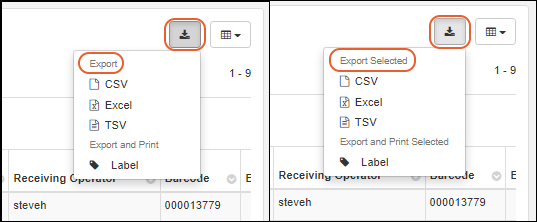
Notice the menu indicates whether you are exporting rows you have selected or the entire grid. To export the full grid, select no rows.
Multi-tab Excel Exports
When you export from a grid that contains multiple tabs, such as one containing samples of different types as shown below, the exported Excel file can also include multiple tabs (sheets). Select
> Excel, then in the popup, you will see the per-tab
Count and which
View will be used for each tab. Check the boxes for the tabs you want included in the export and click
Export.
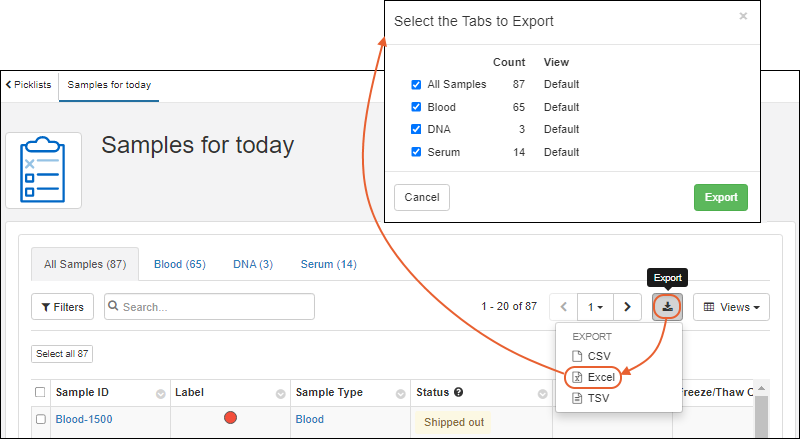
Related Topics

